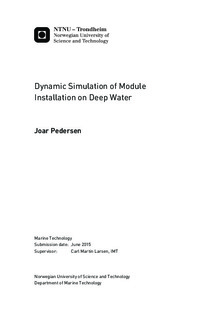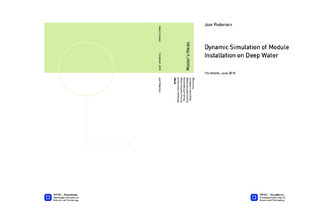| dc.description.abstract | The Aasta Hansteen field is a gas field outside the coast of Northern Norway. Production is planned to start in 2017. The gas field is situated at 1300m water depth the deepest on the Norwegian continental shelf. During the summer of 2015, subsea manifolds are going to be in- stalled by Subsea 7 by use of a crane vessel.
Installing the 191 tonnes heavy modules is done by use of a single lifting wire. In order for such an installation to be safe and cost effective, it has to be well planned. Part of this planning is a dynamic analysis of the lowering operation. A structural model with certain hydrodynamic properties is created in RIFLEX. The hydrodynamic properties are taken from DNV s RP-H103 and a report by Øritsland (1989) containing findings from model tests with subsea modules. Subsea 7 has provided the structural properties of the lifting wire and slings, as well as RAOs for the crane vessel.
Eigenperiods, RAOs for crane tip motion and RAOs for wire tension are found through time- domain simulations in RIFLEX. The eigenperiods are found by use of response spectra from irregular analyses. RAOs are found by regular wave analysis with different wave periods. Crane tip responses are largest for periods around 7s, with a minor peak at 10s. Eigenperiods for the manifold response are from approximately 2s to 6s, depending on the vertical position of the module. In addition to the RIFLEX model, a separate MATLAB model has been created. The MATLAB model is a simplified version of the one in RIFLEX, only calculating responses in verti- cal direction using Newmark-β for solving the equation of motion in time-domain. Responses are calculated based on regular waves and RAOs for crane tip motion gathered from RIFLEX.
Results from MATLAB and RIFLEX have been compared, and are in general similar in magni- tude. For certain combinations of depth and wave periods the difference is however significant. The reason for this might be the difference in response calculations, where RIFLEX is a non- linear FEM-program and my MATLAB code is linear. | |

